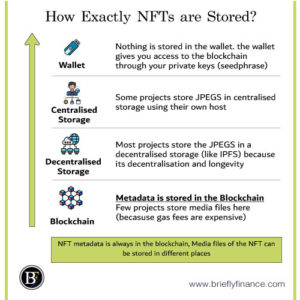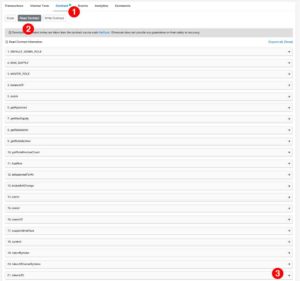When buying NFTs, you generally buy the code behind it but you do not necessarily buy the image or media file that represent it. In this article we will identify exactly where do the NFTs metadata and associate media file is stored.
NFT metadata is always stored in the Blockchain while the media files associated with it could be stored in the blockchain, decentralised storage or centralised storage.

Attribution: The icons has been designed using resources from Flaticon.com
So basically, when you buy a NFT you own the metadata on the blockchain where you can access it through your wallet. This metadata has a link directed to an image (or whatever media file it is) to the storage location.
Why not just keep it simple and store it in the blockchain?
Main reason behind not storing the files in the blockchain is because it is expensive.
As referenced in XP.Network
Blockchain isn’t designed for storing media like videos and digital artworks. The cost of storage on Ethereum is 640k gas per kilobyte, so at the current gas price of 30 gwei it will cost you 19.7 ETH or almost $50,000 to store a 1 Mb image.
Let us explore more…
Quick Recap
Blockchain technology is basically a peer-to-peer network that is related to a certain cryptocurrency (we will focus on Ethereum network) and stores the data in it.
So instead of having one place to store the data in the past (like a hosting service). On the blockchain, data is stored on multiple computers around the world.
Stored on the Blockchain
Despite the fact storing media files directly in the blockchain is expensive, some projects store the media in there because this insures that the holder have full ownership of the artwork and the Metadata associated with it.
Storing the NFT in the blockchain is technically the safest way and ensures that the media file wont disappear as long as the Blockchain is around.
Some projects like Art Blocks still decided to sell their NFTs while keep both the metadata and art on the Blockchain just to maintain the decentralised and immutability aspect.
Decentralised Storage
Another way to ensure longevity of your NFT collections is by using decentralised storage which most collections do that.
Such storage like InterPlanetary File System which stands for IPFS is built on a peer-to-peer network similar to how the blockchain technology works but it is a specialised for storing larger file sizes.
With such technology even if one of the hosted servers is it going to be out, the NFT will still remain visible because there are other servers in the network that will still host this image.
Centralised Storage
The concept of decentralised storage is not necessarily the solution. Some NFTs are mainly based on the utility the creator provides.
For the example, a well-known influencer like Tom Bilyeu from Impact Theory Founders Key. His holders are benefiting from the utility the keys provide and they trust that as long as this person going to work in the project there should be no issue for him to host the NFTs wherever it is (currently I found out that its on Google service).
What is in the Wallet then?
You may wonder now, then what is in my wallet?
The wallet has nothing! Lol
The wallet is basically gives you access through your private keys (your seed phrase) to transact with the blockchain.
The wallet help you to verify/transact with the NFT you hold to access web 3.0 utilities which is a proof of who is the true holder and creator of the NFT .
How to check where your NFT is stored?
Now you know the different ways creators store the media files of NFTs, let us go through how you can find out yourself.
The most common marketplace to buy NFTs is Opensea so let us take it as an example (it applies to other marketplaces, you just need to find the contract address and the blockchain explorer associated with it)
Step 1: Visit a NFT item in a collection and click on the details arrow. You will see the contract address and Token ID. Copy the token ID (for later) and click on the contract address.

Source: Bears Deluxe Collection Item https://www.bearsdeluxe.io/bears/5463
This will take you to Etherscan a blockchain explorer of Ethereum network. Where you can also directly copy paste the contract address in the platform to visit the same page.
Step 2: Scroll down click on contract. Read contract and open the token URI tab

Sometimes it is different depending on how the contract is programmed. Just make sure to look for token/metadata related tabs that you can query with the token ID (which we copied on step 1).
Step 3: paste the token ID in the query field that will generate a link.

As first impression, we already realised that it is saved in IPFS given the link provided. But let us visit this link for the sake of it.

You will see code like the above, it represents the metadata of this token. Also you will see where the image is linked to which is through Pinata a service provider that host media on IPFS.
There should also be another way through reading the code which I still didn’t understand. But this trick works!
Final Thoughts
Despite that the majority of the NFTs projects are stored on a decentralised/centralised storage it does not necessarily mean that you can lose it all. As long as you did your own research and trust the creator of the NFT it wont matter where the media file is stored.
Also, if the storage server went down it should be easy to redirect the metadata to new storage provider.
Related Posts:
- Cryptocurrency for Dummies – Everything I learned About it
- Can NFTs be Hacked? – 4 Ways to Keep your NFTs Safe
- Are NFTs a Scam? 5 Reasons why not all NFTs are a Scam
Disclaimer: Above links are affiliate links and at no additional cost to you. I may earn a commission. Know that I only recommend products, tools, services and learning resources I’ve personally used and believe are genuinely helpful and relevant. It is not because of the small commissions I make if you decide to purchase them. Most of all, I would never advocate for buying something that you can’t afford or that you’re not yet ready to implement.
